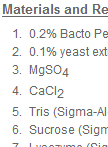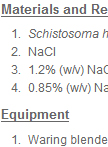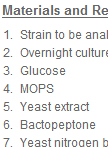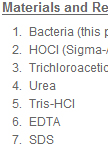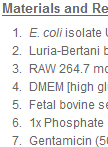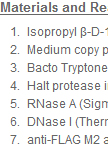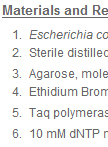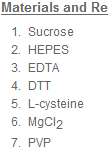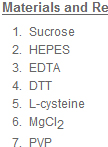Improve Research Reproducibility A Bio-protocol resource
- Protocols
- Articles and Issues
- About
- Become a Reviewer
Past Issue in 2012
Volume: 2, Issue: 20
Biochemistry
Isolate and Sub-fractionate Cell Membranes from Caulobacter crescentus
Cell membranes from Caulobacter can be isolated and separated into inner and outer membranes according their characteristic buoyant densities on a sucrose gradient. Fractionation can be used to determine the localisation of uncharacterised proteins and to enrich protein complexes present in either of these membranes for biochemical analysis such blue-native PAGE and immunoprecipitation.
Immunology
Schistosoma haematobium Egg Isolation
Schistosoma haematobiumis the etiologic agent for urogenital schistosomiasis, a major source of morbidity and mortality for more than 112 million people worldwide. Infection with S. haematobium results in a variety of immunopathologic sequelae caused by parasite oviposition within the urinary tract, which drives inflammation, hematuria, fibrosis, bladder dysfunction, and increased susceptibility to urothelial carcinoma. Since most of the pathology in schistosomasis is directly attributable to the host reaction to eggs and egg-associated antigens, their isolation and study are important experimental techniques. S. haematobium eggs can be collected from infected tissues for injection into other animals or preparation of crude egg extracts. This protocol describes a simple way to isolate eggs.Schistosomes are a biohazard. Workers should wear latex gloves at all times when handling schistosomal materials or any tissues from infected animals.
Microbiology
Minimum Inhibitory Concentration (MIC) Assay for Antifungal Drugs
The Minimum Inhibitory Concentration (MIC) Assay is widely used to measure the susceptibility of yeasts to antifungal agents. In serial two-fold dilutions, the lowest concentration of antifungal drug that is sufficient to inhibit fungal growth is the MIC. Typically, 50% inhibitory (MIC50) or 80% inhibitory (MIC80) values are reported. To facilitate visualization of antifungal susceptibility data, heat maps are generated whereby optical density values are represented quantitatively with colour.
Differential in vivo Thiol Trapping with N-ethylmaleimide (NEM) and 4-acetamido-4'-maleimidylstilbene-2,2'-disulfonic acid (AMS)
This protocol is used to compare the in vivo redox status of Escherichia coli and Vibrio cholerae protein before and after HOCl treatment. For example, I examined whether the EF-Tu protein is reduced or oxidized in the referenced publication. This protocol should work for other proteins and other oxidative stress treatments. You will need the antibody for your protein to visualize your protein on western blot.
Intracellular Macrophage Infections with E. coli under Nitrosative Stress
Escherichia coli (E. coli) produces disseminated infections of the urinary tract, blood, and central nervous system where it encounters professional phagocytes such as macrophages, which utilize reactive nitrogen intermediates (RNI) to arrest bacteria. In vitro, extraintestinal pathogenic E. coli (ExPEC) can survive within bone marrow-derived macrophages for greater than 24 h post-infection within a LAMP1+ vesicular compartment, and ExPEC strains, in particular, are better adapted to intracellular macrophage survival than commensal strains (Bokil et al., 2011). This protocol details an intracellular murine macrophage-like cell infection, including modulation of the host nitrosative stress response, to model this host-pathogen interaction in vitro. To accomplish this, RAW 264.7 murine macrophage-like cells are pre-incubated with either L-arginine, an NO precursor, or IFNγ to yield a high nitric oxide (NO) physiological state, or L-NAME, an inducible NO synthase (iNOS)-specific inhibitor, to yield a low NO physiological state. This protocol has been successfully utilized to assess the contribution of a novel ExPEC regulator to intracellular survival and the nitrosative stress response during macrophage infections (Bateman and Seed, 2012), but can be adapted for use with a variety of E. coli strains or isogenic deletions.
Isolation of Inner Membrane Vesicles from Escherichia coli by Using an Affinity Tag
This protocol was developed in a project aimed to identify the inner membrane proteins localizing to cell poles in Escherichia coli (E. coli). By using a known polar protein Tar as a tag, we isolated pole-derived inner membrane vesicles by affinity capture. The specificity of the polar vesicle isolation was confirmed by mass spectrometry that identified more than one hundred proteins, most of which are known inner membrane proteins, including other known polar proteins. This protocol, or if adapted properly by choosing other affinity targets, is well suited to isolate other membrane domains of interest for identification of proteins or lipid composition.
Promoter Orientation of Prokaryotic Phase-variable Genes by PCR
One major mechanism of phase variable gene expression in prokaryotes is through inversion of the promoter element for a gene or operon. This protocol describes how to detect the promoter orientation of a phase-variable gene by PCR. This protocol, including primer design, is specific to detection of the promoter orientations of hyxR, a LuxR-like response regulator in Extraintestinal Pathogenic Escherichia coli (ExPEC) isolates (Bateman and Seed, 2012); however, this protocol can be generalized to other organisms and genes to discriminate prokaryotic promoter inversions by PCR through size discrimination of the amplification products. Expression of hyxR is regulated through bidirectional phase inversion of the upstream promoter region mediated by a member of the family of site-specific tyrosine recombinases called Fim-like recombinases. The recombinases recognize inverted DNA repeat sequences flanking the promoter and produce a genomic rearrangement, orientating the promoter in favor or disfavor of gene expression.
Plant Science
Measurement of NADPH Oxidase Activity in Plants
NADPH oxidase is a membrane-bound enzyme that generates (O2-) by transferring electrons from NADPH to molecular oxygen O2. O2-is spontaneously dismasted to the more stable form H2O2. Both O2-and H2O2 are forms ofreactive oxygen species (ROS), which are involved in regulation of many cellular activities such as transcription, intracellular signaling, and host defense. The NADPH oxidase - dependent generation of O2- in total membrane fraction of plant tissue has been determined by the reduction of the tetrazolium salt XTT by O2-. In the presence of O2-, XTT generates a soluble yellow formazan that can be quantified spectrophotometrically.
Glycolate Oxidase Activity Assay in Plants
Glycolate oxidase is located in the peroxisome and is involved in the photorespiratory cycle which recovers some of the carbon loss during photosynthesis. Glycolate oxidase converts glycolate to glyxoylate with the concomitant production of H2O2.In this assay, the H2O2 generated, in the presence of HRP, oxidizes O-dianisidine into a colored O-dianisidine radical cation that can be quantified spectrophotometrically. The amount of color produces is directly proportional to the glycolate oxidase activity.


